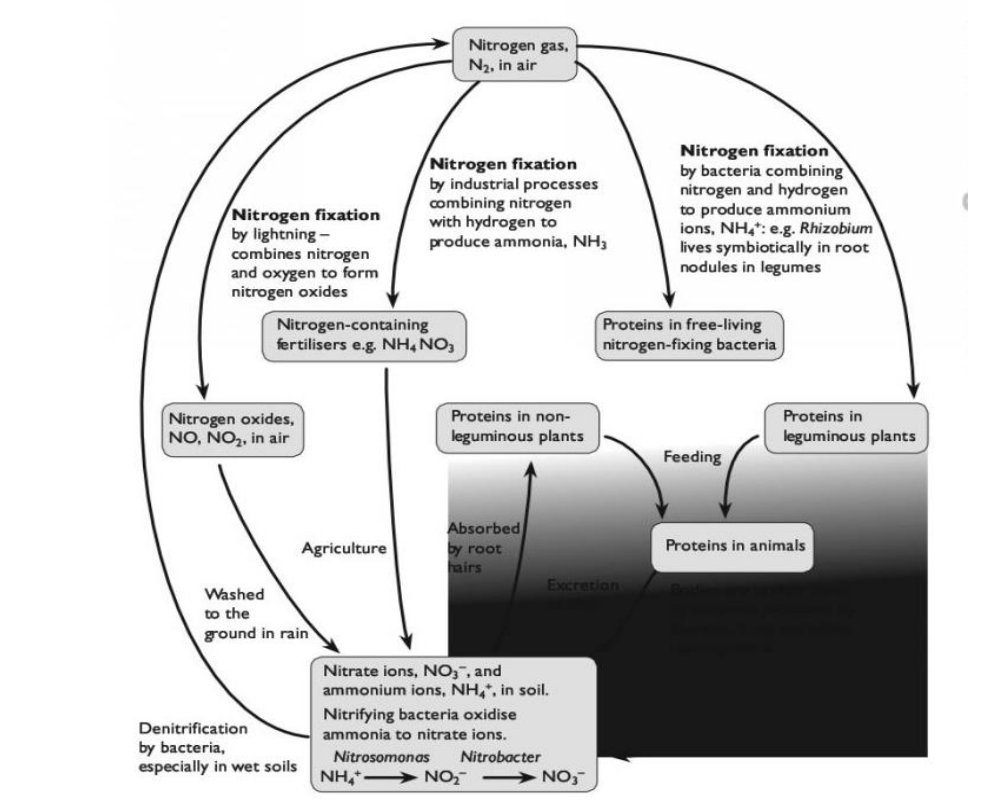- Nitrogen in the atmosphere is very insert & it takes place a lot of energy to split it, the bonds in the molecule so that it can form other compounds such as nitrates & nitrites.
- Nitrogen is an essential component of biological molecules such as protein & DNA
- The only organism capable of splitting nitrogen are few bacteria & algae. they use it form nitrites & nitrates, a process known As nitrification
- This is the major way in which nitrogen enters the biotic component of the ecosystem.
Nitrogen fixation.
- Is energy consuming process (endothermic reaction) because the two nitrogen atoms of the nitrogen molecules must be separated?
- Nitrogen fixers achieve this by using the enzyme nitrogenase & energy from ATP.
- Non enzymatic separation requires the much greater energy of industrial process / of ionizing radiation
- There is no counter balancing removal mechanism taking industrial / fixed nitrogen back to the atmospheric reservor pool.
- A regulation n small amount of nitrogen (5- 10 %) is formed by ionizing events in the atmosphere, the resulting nitrogen oxides dissolve in the rain forming nitrites
- The legumes such as clover, soya beans & peas are probably the greatest natural sources of fixed nitrogen.
- Their roots possess character swellings called nodules which caused by colonies of nitrogen fixing bacteria living within the soils.
- The relationship is mutualistic because the plant gain fixed nitrogen in the form of ammonia from the bacteria & in return the bacteria gains energy and certain nutrients such as carbohydrates from the plant.
- Legumes can contribute as much as 100 times more fixed nitrogen than free living bacteria.
- All nitrogen fixers Inco-operate nitrogen into ammonia but this is immediately used to make organic compounds mainly proteins.

Nitrification
- Nitrifying bacteria can oxidize ammonia to nitrate in two stages:
- i) nitrite ions NH4- → NO2-(Nitrosomonas)
- ii) nitrate ions NO2- → NO3-(Nitrobacter ).
- The nitrate ions can then be taken up by plant roots
Q/A. Describe the role played by microorganisms in the Nitrogen cycle [6]
Emphasis should have been placed on specific organisms and the part they play in the Nitrogen cycle. The following points are expected:
- saphrophytic bacteria/ fungi feed on dead organisms or waste/ decompose dead organisms or waste
- releasing ammonium compounds /ammonia
- nitrifying bacteria/ Nitrosomonas
- oxidize ammonia or ammonium compounds to nitrates.
- oxidation of nitrates to nitrates by free-living bacteria/ nitrobacter/ nitrococcus
- nitrogen fixing bacteria/ rhizobium/ mutualistic blue-green bacteria/ free- living green bacteria/ Azotobacter/ clostridium
- convert (gaseous) nitrogen into ammonia/nitrates
- denitrificans
- converts nitrates (in the soil) into gaseous nitrogen.
Q/A Explain the role of nitrifying bacteria and denitrifying bacteria in the Nitrogen Cycle.
- nitrifying bacteria;
- convert, ammonium / NH4+ , to , nitrate III / nitrite / NO2- ; A ammonia / NH3
- nitrite, converted to, nitrate (V) / NO3- ;
- requires, aerobic conditions / oxygen / aerated soil;
- (nitrate (V) ions) can be, taken up / used, by plants;
- denitrifying bacteria;
- remove nitrate (V) (ions) / convert nitrate (V) (ions) to nitrogen (gas);
- in, anaerobic conditions / oxygen poor soil / non-aerated soil;
- recycles nitrogen / further use of nitrogen (by fixing);
- prevents nitrogen being trapped
Decay and Ammonification.
Animals excrete nitrogen-containing compounds such as ammonia and urea. When they die, protein molecules in their bodies are broken down by enzymes produced by bacteria, fungi and other decomposer organisms. These processes add ammonia and ammonium ions to the soil.
Denitrification.
- The anaerobic denitrifying bacteria convert nitrate to N2 and NOx, which is then lost to the air.